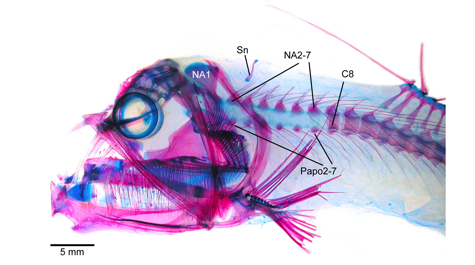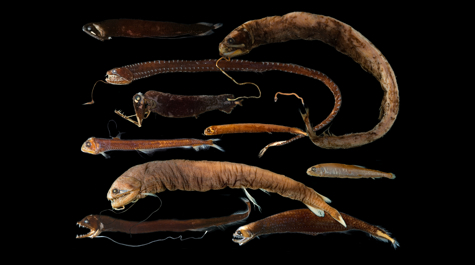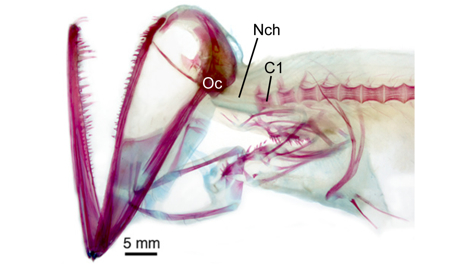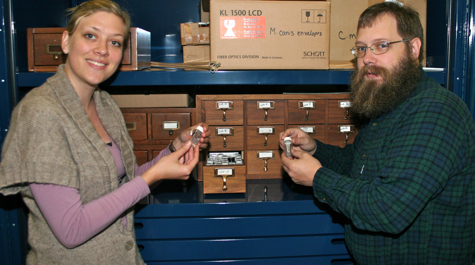The neck bone’s connected to the head bone—or is it?
VIMS post-doctoral fellow studies puzzling gap in skeleton of deep-sea fishes
The traditional children’s song Dem Bones says the neck bone’s connected to the head bone. Research by VIMS post-doctoral fellow Nalani Schnell shows that isn’t true—at least for a certain group of deep-sea fishes.
Schnell, whose Ph.D. research at the University of Tübingen in Germany concerned the “Complex structure and ontogeny of the occipito-vertebral gap in barbeled dragonfishes,” arrived at VIMS in September to begin a 1-year post-doctoral fellowship with professor Eric Hilton.
Her plans while at VIMS include preparing for publication the voluminous and invaluable lecture notes compiled by late professor John Olney for his course on the Early Life History of Marine Fishes (taught jointly with professor Ed Houde of the University of Maryland). Her effort will include close study of professor Olney’s larval fish collection, which Schnell calls “one of the finest in the world." With 500 lots and 1,500 specimens representing about 190 families of marine fish, it is also one of the world’s largest teaching collections.

Schnell first became interested in working at VIMS after taking Olney and Houde’s larval fish course during the summer of 2008. Study of larval fish provides information that is important to a wide range of fields, from taxonomy and systematics to marine ecology, developmental biology, and fisheries management.
But back to those deep-sea dragonfishes, small but fearsome-looking creatures that come with oversize teeth, bioluminescent organs,and a “fishing lure” that is thought to attract prey.
Schnell undertook her study of these fishes to help address a long-standing question in deep-sea biology—the developmental processes that lead to a gap between the fishes’ skull and backbone. Close observation of dragonfishes—begun with pioneering studies in the 1930s—reveals that their vertebrae do not connect with the occipital bones at the base of the skull, as if a person had no bones in their neck.
Studying the anatomical puzzle of this “occipito-vertebral gap” required countless hours in the laboratory with colleagues, both at the National Museum in London and the National Museum of Natural History at the Smithsonian Institution in Washington, D.C.
The team’s study of larval and adult specimens confirmed that all 27 major groups of dragonfishes—representing more than 270 species—feature the characteristic gap. But, contrary to earlier studies, the team found vertebrae missing in members of only 2 genera (Chauliodus and Eustomias) and one species (Leptostomias gladiator).
In the other dragonfish groups, the team discovered that the gap is due not to a loss of vertebrae, but to an extension of the notochord—the flexible, rod-shaped structure that is replaced by the vertebrate backbone during larval development.
They also discovered that the vertebrae in dragonfishes develop from the tail toward the head—opposite that of most other bony fishes. Schnell thinks that this may help explain how the gap arises during development: ossification of the notochord into the bony structure of the vertebrae simply doesn’t quite make it all the way forward to the skull as larval dragonfish mature into adults. Retention of juvenile characters into the adult form—called neotony—is a common cause of evolutionary change.
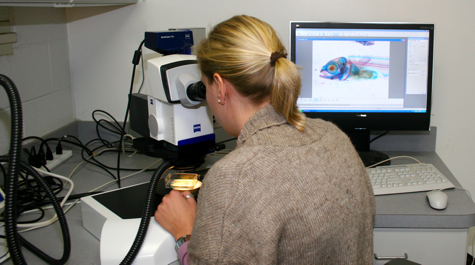
But Schnell says a solid explanation for the evolution of the occipito-vertebral gap remains elusive. Some researchers think it might reflect the difficulty of producing the calcium phosphate of bone within the cold and relatively acidic waters of the deep sea. Others contend that it’s an adaptation that allows the dragonfishes to open their jaws more widely, in order to swallow the occasional large prey items they might come across among the otherwise meager pickings of the deep-sea ecosystem. What is clear is that more research will be needed to finally solve the puzzle.
Schnell’s work, published in August in the Journal of Morphology with Ralf Britz of London’s Natural History Museum and Dave Johnson of the Smithsonian, won the 2010 Reinhard Rieger Award for research excellence in zoomorphology. The award, given by John Wiley & Sons, Springer, and the Institute of Zoology at the University of Innsbruck, cites the paper for “its beauty and simplicity,” and acknowledges “the groundbreaking nature” of the work.

